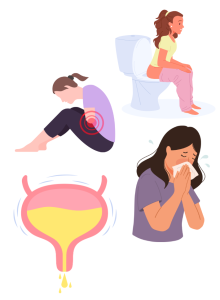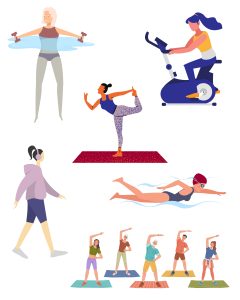7
Taking Care of the Pelvic Floor
Having a healthy functioning pelvic floor is crucial to optimal health and wellness. How can we promote pelvic floor health?
Signs of Pelvic Floor Dysfunction:
Pelvic floor dysfunction can present itself in various ways. We will discuss pelvic floor dysfunction in more depth later in the Pressbook, however, here is a brief overview of some common indications that your pelvic floor needs attention.
- Pelvic floor pain

- Unintentional leakage from laughing, coughing, sneezing, exercising, etc.
- Urgency to get to the bathroom in time
- Frequency of needing to go to the bathroom
- Challenges with fully emptying your bowels or bladder
- Painful intercourse
Who may suffer from pelvic floor dysfunction?
Anyone can suffer from pelvic floor dysfunction, but some individuals have an increased risk. Those individuals include but are not limited to:
- pregnant women
- women who have given birth
- women in menopause
- women who have had a hysterectomy
- men who have had a prostatectomy
- runners or gymnasts
Additional risk factors may include:
- injury to the pelvic area
- back pain
- constipation
- chronic cough
- overweight or obesity
- job or exercise routine requiring heavy weight lifting
Exercise and the pelvic floor:
Exercising is beneficial for both your physical and mental health. Some exercises are better than others in nurturing the pelvic floor.
Exercises that may negatively strain the pelvic floor include:
- running
- jumping
- boxing
- high impact workout routines
- sit-ups
- crunches
- deep or wide-leg squats
- heavy weight lifting
- agility sports (tennis, basketball, football)

Exercises that are pelvic-floor friendly:
- walking
- seated cycling machine
- swimming
- low intensity water aerobics
- low impact exercise routines
Occupational therapy and pelvic floor:
Occupational therapy plays a crucial role in helping individuals with pelvic floor dysfunction enhance their overall well-being and participate more fully in daily activities. Pelvic floor dysfunction can significantly affect various daily occupations, including urination, elimination, and sexual activity, leading to discomfort and decreased quality of life.
One important aspect to consider is the connection between the pelvic floor, posture, and breathing. Proper alignment and efficient breathing patterns are essential not just for pelvic health, but for the performance of most daily activities. Occupational therapists employ techniques to improve patients’ awareness of their body mechanics, promote effective pelvic floor muscle function, and integrate strategies that support better posture and breathing.
Through personalized interventions, occupational therapists empower patients to regain control, enhance their functional abilities, and engage more meaningfully in activities that hold significance for them. This holistic approach can lead to not only functional improvements but also a positive impact on overall quality of life.
Interventions may include, but are not limited to:
- Behavioral re-training, lifestyle modifications, mindfulness, relaxation, emotional regulation
- Biofeedback, functional mobility, manual therapies, therapeutic activities, therapeutic exercises
- Education on role transitioning, co-occupations, sexual activity, and intimacy
- Environmental modifications, adaptive clothing, habit and routine training
- Medication management, pain management, schedule training, personal hygiene
- Nutrition and hydration management, exercise, sleep hygiene
Key Takeaways
- Occupational therapy is essential for individuals with pelvic floor dysfunction, impacting daily activities like urination and sexual function. Therapists focus on the connection between pelvic health, posture, and breathing, using techniques to improve awareness and muscle function. This personalized approach helps patients regain control, enhance their abilities, and improve quality of life.
Exercises
- Pick one intervention above and think how this could be effective for your pelvic health
Explore
References:
Continence Foundation of Australia. (2022). Protect your pelvic floor and stay in control. Pelvic Floor First. https://continence.my.salesforce.com/sfc/p/#A0000000KUc9/a/5K0000004KMU/RXD347.G_sM4YZMtEJPW9BoGRdZHcCZJ90dHYFDdmi0
Continued. (2023, May 10). Occupational therapy and the pelvic floor. https://www.occupationaltherapy.com/articles/occupational-therapy-and-pelvic-floor-5599
Media Attributions
- dysfunction
- safe pelvic floor exercises
